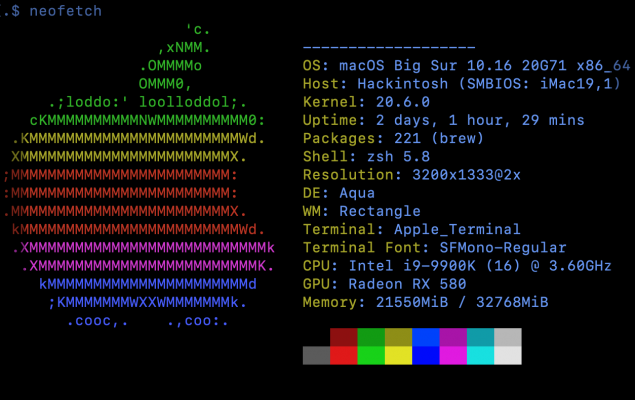- Joined
- Sep 29, 2017
- Messages
- 99
- Motherboard
- ASUS P9X79 WS
- CPU
- i7-3930K
- Graphics
- HD 7950
- Mac
- Classic Mac
- Mobile Phone
I've been struggling for days to upgrade my four-year-old Sierra build (which is still running on the install and EFI that I perfected in 2017).
I keep trying to make a bootable Big Sur install USB and it never works. (I want to install on a second, blank SSD I've installed, but I never get that far.) So far I've
1) Downloaded the full Big Sur Installer
2) Formatted a USB drive Mac OS Extended (Journaled)/GUID Partition
3) Used the "createinstallmedia" sudo command to make the USB drive into "Install macOS Big Sur"
4) Used the current "Clover Configurator" to mount the USB drive's EFI partition
5) Used the current "Clover Configurator" to install Clover onto the USB drive's EFI partition
6) Downloaded and copied over the 7 recommended kexts into EFI/CLOVER/kexts/Other:
CPUFriend.kext
Lilu.kext
VoodooPS2Controller.kext
realtekALC.kext
FakeSMC.kext
USBInjectAll.kext
WhateverGreen.kext
7) Rebooted
It doesn't work. After the Clover selector screen (where I can use the mouse to choose the USB drive to boot) I get four lines of text:
27:849 0:000 There are problems in plist '\EFI\CLOVER\config.plist'
27:850 0:000 Warning: ProductName is not defined. The whole SMBIOS dict is ignored at line 1194.
27:852 0:001 Warning: FixHeaders exists in ACPI and ACPI/DSDT/Fixes. Delete FixHeaders from ACPI/DSDT/Fixes.
27:853 0:001 Use CloverConfigPlistValidator or look in the log
Then it goes to a circle with a diagonal line and an Apple URL.
When I replace the EFI directory with a copy of my current working directory (from the EFI partition of my Sierra boot drive) it just boots to my Sierra boot drive.
I've been struggling with this for hours and I can't get anywhere. I tried replacing just the config.plist file with the current working one I have, but that doesn't work either.
I realize I should be configuring the EFI and config.plist files on the USB drive using Clover Configurator but I can't find any guides on the site on how to do this: they all want me to use UniBeast (rather than Clover).
Will the EFI files on the USB installer be the same as the eventual EFI directory on the new Big Sur install (when I get that far)?
Can I simply upgrade Sierra to Big Sur using Apple's installer on my existing install?
Am I "shooting too high" trying to get to Big Sur, anyway? Given my specs (including my "new" Sapphire card), should I be upgrading to something in between like Catalina?
Thanks in advance for any help or advice. I'm very frustrated — I'm sure there's something obvious I'm missing but I haven't been able to find the guidance I need.
Jordan
I keep trying to make a bootable Big Sur install USB and it never works. (I want to install on a second, blank SSD I've installed, but I never get that far.) So far I've
1) Downloaded the full Big Sur Installer
2) Formatted a USB drive Mac OS Extended (Journaled)/GUID Partition
3) Used the "createinstallmedia" sudo command to make the USB drive into "Install macOS Big Sur"
4) Used the current "Clover Configurator" to mount the USB drive's EFI partition
5) Used the current "Clover Configurator" to install Clover onto the USB drive's EFI partition
6) Downloaded and copied over the 7 recommended kexts into EFI/CLOVER/kexts/Other:
CPUFriend.kext
Lilu.kext
VoodooPS2Controller.kext
realtekALC.kext
FakeSMC.kext
USBInjectAll.kext
WhateverGreen.kext
7) Rebooted
It doesn't work. After the Clover selector screen (where I can use the mouse to choose the USB drive to boot) I get four lines of text:
27:849 0:000 There are problems in plist '\EFI\CLOVER\config.plist'
27:850 0:000 Warning: ProductName is not defined. The whole SMBIOS dict is ignored at line 1194.
27:852 0:001 Warning: FixHeaders exists in ACPI and ACPI/DSDT/Fixes. Delete FixHeaders from ACPI/DSDT/Fixes.
27:853 0:001 Use CloverConfigPlistValidator or look in the log
Then it goes to a circle with a diagonal line and an Apple URL.
When I replace the EFI directory with a copy of my current working directory (from the EFI partition of my Sierra boot drive) it just boots to my Sierra boot drive.
I've been struggling with this for hours and I can't get anywhere. I tried replacing just the config.plist file with the current working one I have, but that doesn't work either.
I realize I should be configuring the EFI and config.plist files on the USB drive using Clover Configurator but I can't find any guides on the site on how to do this: they all want me to use UniBeast (rather than Clover).
Will the EFI files on the USB installer be the same as the eventual EFI directory on the new Big Sur install (when I get that far)?
Can I simply upgrade Sierra to Big Sur using Apple's installer on my existing install?
Am I "shooting too high" trying to get to Big Sur, anyway? Given my specs (including my "new" Sapphire card), should I be upgrading to something in between like Catalina?
Thanks in advance for any help or advice. I'm very frustrated — I'm sure there's something obvious I'm missing but I haven't been able to find the guidance I need.
Jordan

